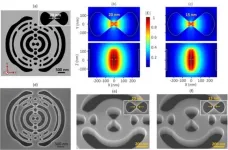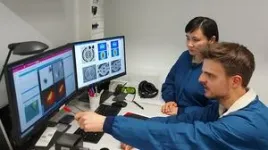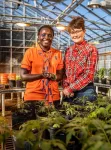(Press-News.org) WASHINGTON — As we transition to a new era in computing, there is a need for new devices that integrate electronic and photonic functionalities at the nanoscale while enhancing the interaction between photons and electrons. In an important step toward fulfilling this need, researchers have developed a new III-V semiconductor nanocavity that confines light at levels below the so-called diffraction limit.
“Nanocavities with ultrasmall mode volumes hold great promise for improving a wide range of photonic devices and technologies, from lasers and LEDs to quantum communication and sensing, while also opening up possibilities in emerging fields such as quantum computing,” said the leading author Meng Xiong from the Technical University of Denmark. “For example, light sources based on these nanocavities could significantly improve communication by enabling faster data transmission and strongly reduced energy consumption.”
In the journal Optical Materials Express, the researchers show that their new nanocavity exhibits a mode volume an order of magnitude smaller than previously demonstrated in III-V materials. III-V semiconductors have unique properties that make them ideal for optoelectronic devices. The strong spatial confinement of light demonstrated in this work helps enhance light-matter interaction, which allows higher LED powers, smaller laser thresholds and higher single-photon efficiencies.
“Light sources based on these new nanocavities could have a major impact on data centers and computers, where ohmic and power-hungry connections could be replaced by high-speed and low-energy optical links,” said Xiong. “They could also be used in advanced imaging techniques such as super-resolution microscopy to enable better disease detection and treatment monitoring or to improve sensors for various applications, including environmental monitoring, food safety and security.”
Boosting light interaction
The work is part of an effort by researchers at the Technical University of Denmark’s NanoPhoton – Center for Nanophotonics who are exploring a new class of dielectric optical cavities that enable deep subwavelength confinement of light through a principle the researchers have coined extreme dielectric confinement (EDC). By enhancing the interaction between light and matter, EDC cavities could lead to highly efficient computers with deep-subwavelength lasers and photodetectors that are integrated into transistors for reduced energy consumption.
In the new work, the researchers first designed an EDC cavity in the III-V semiconductor indium phosphide (InP) using a systematic mathematical approach that optimized the topology while relaxing geometric constraints. They then fabricated the structure using electron beam lithography and dry etching.
“EDC nanocavities have feature sizes down to a few nanometers, which is crucial for achieving extreme light concentration, but they also come with a significant sensitivity to fabrication variations,” said Xiong. “We attribute successful realization of the cavity to the improved accuracy of the InP fabrication platform, which is based on electron beam lithography followed by dry etching.”
Making a smaller nanocavity
After refining the fabrication process, the researchers achieved a remarkably small dielectric feature size of 20 nm, which became the basis for the second round of topological optimization. This last round of optimization produced a nanocavity with a mode volume of just 0.26 (λ/2n)³, where λ represents the wavelength of light and n its refractive index. This achievement is four times smaller than what is often termed the diffraction-limited volume for a nanocavity, which corresponds to a box of light with a side-length of half the wavelength.
The researchers point out that although similar cavities with these characteristics were recently achieved in silicon, silicon lacks the direct band-to-band transitions found in III-V semiconductors, which are essential for harnessing the Purcell enhancement provided by nanocavities. “Prior to our work, it was uncertain whether similar outcomes could be achieved in III-V semiconductors because they don't benefit from the advanced fabrication techniques developed for the silicon electronics industry,” said Xiong.
The researchers are now working to improve the fabrication precision to further reduce the mode volume. They also want to use the EDC cavities to achieve a practical nanolaser or nanoLED.
Paper: M. Xiong, R. E. Christiansen, F. Schroder, Y. Yu, L. Nevenka Casses, E. Semenova, K. Yvind, N. Strenger, O. Sigmund, J. Mork, “Experimental realization of deep sub-wavelength confinement of light in a topology-optimized InP nanocavity,” Opt. Mater. Express Vol. 14, Issue 2, pp. 397-406 (2024).
DOI: https://doi.org/10.1364/OME.513625
About Optical Materials Express
Optical Materials Express is an open-access journal focusing on the synthesis, processing and characterization of materials for applications in optics and photonics. It is published by Optica Publishing Group and emphasizes advances in novel optical materials, their properties, modeling, synthesis and fabrication techniques; how such materials contribute to novel optical behavior; and how they enable new or improved optical devices. The Editor-in-Chief is Andrea Alù from City University of New York, USA. For more information. For more information, visit Optical Materials Express.
About Optica Publishing Group
Optica Publishing Group is a division of Optica, the society progressing light science and technology. It publishes the largest collection of peer-reviewed content in optics and photonics, including 18 prestigious journals, the society’s flagship member magazine, and papers from more than 835 conferences, including 6,500+ associated videos. With over 400,000 journal articles, conference papers and videos to search, discover and access, Optica Publishing Group represents the full range of research in the field from around the globe.
END
Sub-wavelength confinement of light demonstrated in indium phosphide nanocavity
New nanocavities pave the way for enhanced nanoscale lasers and LEDs that could enable faster data transmission using smaller, more energy-efficient devices
2024-01-24
ELSE PRESS RELEASES FROM THIS DATE:
Laura M. Barzilai, JD, LLM, elected Chair of Board of Directors of the American Federation for Aging Research (AFAR)
2024-01-24
NEW YORK— The American Federation for Aging Research (AFAR), a national, nonprofit whose mission is to advance and support healthy aging through biomedical research, is pleased to announce the election of Laura M. Barzilai, JD, LLM, as Chair of the Board of Directors.
Stephanie Lederman, EdM, AFAR Executive Director, shares: "The Board of Directors of AFAR unanimously elected Laura Barzilai as Chair in December 2023. For nearly a decade, her contributions as a board member, committee chair, ...
Talking tomatoes: How their communication is influenced by enemies and friends
2024-01-24
Plants produce a range of chemicals known as volatile organic compounds that influence their interactions with the world around them. In a new study, researchers at the University of Illinois Urbana-Champaign investigated how the type and amount of these VOCs change based on different features of tomato plants.
The smell of cut grass is one of the defining fragrances of summer. Smells like that are one of the ways plants signal their injury. Because they cannot run away from danger, plants have evolved to communicate with each other using chemical signals. They use VOCs for a ...
Thomas A. Rando, MD, PhD, elected President of the Board of Directors of the American Federation for Aging Research (AFAR)
2024-01-24
The American Federation for Aging Research (AFAR), a national, nonprofit whose mission is to advance and support healthy aging through biomedical research, is pleased to announce the election of Thomas A. Rando, MD, PhD, as President of the Board of Directors in December 2023.
Dr. Rando is currently the Director of the Eli and Edythe Broad Center of Regenerative Medicine and Stem Cell Biology at UCLA, where he is a professor of Neurology and Molecular, Cell, and Developmental Biology. Previously, he ...
Fast-charging lithium battery seeks to eliminate ‘range anxiety’
2024-01-24
ITHACA, N.Y. – Cornell University engineers have created a new lithium battery that can charge in under five minutes – faster than any such battery on the market – while maintaining stable performance over extended cycles of charging and discharging.
The breakthrough could alleviate “range anxiety” among drivers who worry electric vehicles cannot travel long distances without a time-consuming recharge.
“Range anxiety is a greater barrier to electrification in transportation than any of the other barriers, like cost and capability of batteries, and we have identified a pathway to eliminate it using rational electrode designs,” said Lynden ...
Chemistry professor R. Graham Cooks expands research of water droplet interfaces that offer the secret ingredient for building life
2024-01-24
R. Graham Cooks, the Henry B. Hass Distinguished Professor of Chemistry, and his postdoctoral researcher Lingqi Qiu have experimental evidence that the key step in protein formation can occur in droplets of pure water, and have recently published these findings in the Proceedings of the National Academy of Sciences (PNAS).
In this key step, amino acids are dehydrated (they lose water) even though they are in a water solution, a paradox that is resolved by the fact that these droplet surfaces are unusually dry and highly ...
Brain mechanism teaches mice to avoid bullies
2024-01-24
Like humans, mice live in complex social groups, fight over territory and mates, and learn when it is safer to avoid certain opponents. After losing even a brief fight, the defeated animals will flee from the mice that hurt them for weeks afterward, a new study shows.
Led by researchers at NYU Grossman School of Medicine, the study reveals that such “retreating behavior” is influenced by a distinct area on the underside of the hypothalamus, a part of the brain that controls hunger, sleep, and levels of many hormones. The team had previously found that this special region, called the anterior ventrolateral part of the ventromedial hypothalamus (aVMHvl), ...
New tool reveals gene behavior in bacteria
2024-01-24
Bacterial infections cause millions of deaths each year, with the global threat made worse by the increasing resistance of the microbes to antibiotic treatments. This is due in part to the ability of bacteria to switch genes on and off as they sense environmental changes, including the presence of drugs. Such switching is accomplished through transcription, which converts the DNA in genes into its chemical cousin in mRNA, which guides the building of proteins that make up the microbe’s structure.
For this ...
Chemists use the blockchain to simulate over 4 billion chemical reactions essential to the origins of life
2024-01-24
Cryptocurrency is usually “mined” through the blockchain by asking a computer to perform a complicated mathematical problem in exchange for tokens of cryptocurrency. But in research appearing in the journal Chem on January 24, a team of chemists have repurposed this process, asking computers to instead generate the largest network ever created of chemical reactions which may have given rise to prebiotic molecules on early Earth.
This work indicates that at least some primitive forms of metabolism might have emerged without the involvement of ...
Fracture risk among living kidney donors 25 years after donation
2024-01-24
About The Study: This survey study found a reduced rate of overall fractures but an excess of vertebral fractures among living kidney donors compared with controls after a mean follow-up of 25 years. Treatment of excess vertebral fractures with dietary supplements such as vitamin D3 may reduce the numbers of vertebral fractures and patient morbidity.
Authors: Rajiv Kumar, M.B.B.S., of the Mayo Clinic in Rochester, Minnesota, is the corresponding author.
To access the embargoed study: Visit our For The Media website at this link https://media.jamanetwork.com/
(doi:10.1001/jamanetworkopen.2023.53005)
Editor’s ...
Contrasting characteristics and outcomes of sports-related and non–sports-related traumatic brain injury
2024-01-24
About The Study: In this study of 4,360 patients with traumatic brain injury (TBI), functional limitations six months after injury were common after sports-related TBI, even mild sports-related TBI. Persisting impairment was evident in the sports-related TBI group despite better recovery compared with non–sports-related TBI on measures of mental health and post-concussion symptoms. These findings caution against taking an overoptimistic view of outcomes after sports-related TBI, even if the initial injury appears mild.
Authors: Lindsay Wilson, ...
LAST 30 PRESS RELEASES:
Heart-brain connection: international study reveals the role of the vagus nerve in keeping the heart young
Researchers identify Rb1 as a predictive biomarker for a new therapeutic strategy in some breast cancers
Survey reveals ethical gaps slowing AI adoption in pediatric surgery
Stimulant ADHD medications work differently than thought
AI overestimates how smart people are, according to HSE economists
HSE researchers create genome-wide map of quadruplexes
Scientists boost cell "powerhouses" to burn more calories
Automatic label checking: The missing step in making reliable medical AI
Low daily alcohol intake linked to 50% heightened mouth cancer risk in India
American Meteorological Society announces Rick Spinrad as 2026 President-Elect
Biomass-based carbon capture spotlighted in newly released global climate webinar recording
Illuminating invisible nano pollutants: advanced bioimaging tracks the full journey of emerging nanoscale contaminants in living systems
How does age affect recovery from spinal cord injury?
Novel AI tool offers prognosis for patients with head and neck cancer
Fathers’ microplastic exposure tied to their children’s metabolic problems
Research validates laboratory model for studying high-grade serous ovarian cancer
SIR 2026 delivers transformative breakthroughs in minimally invasive medicine to improve patient care
Stem Cell Reports most downloaded papers of 2025 highlight the breadth and impact of stem cell research
Oxford-led study estimates NHS spends around 3% of its primary and secondary care budget on the health impacts of heat and cold in England
A researcher’s long quest leads to a smart composite breakthrough
Urban wild bees act as “microbial sensors” of city health.
New study finds where you live affects recovery after a hip fracture
Forecasting the impact of fully automated vehicle adoption on US road traffic injuries
Alcohol-related hospitalizations from 2016 to 2022
Semaglutide and hospitalizations in patients with obesity and established cardiovascular disease
Researchers ‘listen in’ to embryo-mother interactions during implantation using a culture system replicating the womb lining
How changing your diet could help save the world
How to make AI truly scalable and reliable for real-time traffic assignment?
Beyond fragmented markets: A new framework for efficient and stable ride-pooling
Can shape priors make road perception more reliable for autonomous driving?
[Press-News.org] Sub-wavelength confinement of light demonstrated in indium phosphide nanocavityNew nanocavities pave the way for enhanced nanoscale lasers and LEDs that could enable faster data transmission using smaller, more energy-efficient devices




